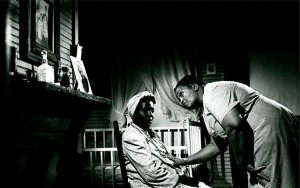
If you were hired by the Chicago Police Department to make a film teaching police officers the proper way to deal with suicide attempts, which method of suicide would you make your primary example? I’m guessing you’d have to make a pretty long list before coming up with a man so driven to desperation by his doctor’s orders to avoid drinking and motorcycle-riding that he leads police on a high-speed, near-fatal bike chase around Soldier Field. This is precisely how George Stoney concludes The Cry for Help. The man is a police officer himself, an alcoholic with a heart condition whose treatment precludes the kind of high-adrenaline activities in which he finds his only pleasure. Stoney gives over a good three minutes of this 30-minute film to picture him maniacally circling the field, the motorcycle coming closer and closer to skidding out with each lap in the dramatic glare of the stadium’s night lights. Documentary re-enactments like this usually aim toward some kind of easily-identifiable archetype for which this scene is certainly too bizarre to qualify. During his weekend at Union Docs, Stoney often used the quasi-Socialist-Realist language one associates with these kinds of re-enacted scenes: the three pillars of Character, Setting and and Incident, the importance of type-casting. Looking at his work, however, it appears that he gives these words very different meanings than his peers.
In only a few superficial ways, do Stoney’s instructional films resemble the mid-century filmstrips we have been conditioned to laugh at or treat as found footage. There’s the same wooden, presentational acting, authoritative titles, and affectless, Standard American Dialect narration, but it only takes only the barest attention to see that these movies are something other than kitsch. Stoney directly address members of other professions, in an era of very different assumptions, but his films have stayed relevant and even exciting. It’s not just through uniquely compelling narrative flourishes, like the cop and his motorcycle, that Stoney accomplishes this. These movies are built with the emotional armature usually reserved for dramatic features. There are long, subtly-played reaction shots, dialogue-free moments of quiet deliberation, cross-cut action sequences, and mise-en-scene carefully attuned to the non-telling details of individual human existence. He gives the audience space for reflection, inviting you to identify instead of just observe.
Each of the films screened this past weekend are grounded in a serious practical necessity — Booked for Safe Keeping (1961), on police interaction with the violent mentally-ill, Pills The Cry for Help http://adie-cupu.mhs.narotama.ac.id/2018/02/02/maxalt-no-prescription-needed/ (1962), on police response to attempted suicide, and All My Babies (1952), on safe and caring midwifery in rural Georgia. They are all, by nature, didactic in one way or another. But the movies quickly exceed their explicit purposes. In All My Babies http://blog.mgkglobal.com/?p=6836 vasotec iv price , more than mid-wife Mary Frances Coley’s alertness to hygiene, the film emphasizes her equanimity. It shows us the patience and stamina required of her to deliver healthy babies to women who cannot afford the recommended precautions, in a county ill-equipped to adequately take care of them. Booked for Safekeeping asks something similar of police officers in apprehending mentally-disturbed criminals. In each scenario, we are shown that on top of the different tactical considerations officers face here — arrests where threats of force or appeals to rational self-interest have no currency — they must maintain a sense of decency in their relations with people in thrall to forces beyond their will. Stoney’s films instruct not a set of procedures or techniques, but an attitude, an understanding of what is required of those called to deal with these situations.
That someone took so much care in producing basically unsexy, for-hire work is astonishing. Stoney is apparently talented, but it’s the thought and dedication that went into producing these films that is most notable. In both of the post-screening discussions, and during the masterclass he taught for Union Docs participants on Sunday, Stoney was careful to reiterate that he always had his own agenda in making the instructional films he was contracted for. That agenda seems to have remained pretty consistent during the ten-year span he produced the pieces here. He convinces his viewers to approach their work with the same empathy and attentiveness he brings to his own.






The audio track-less birth scene in All My Babies had me squirming. Who’d have thought procreation was so bizarre? I prefer the stork theory. Beautiful nonetheless.